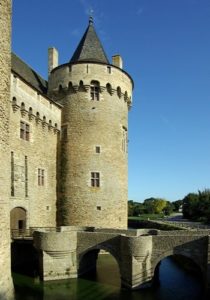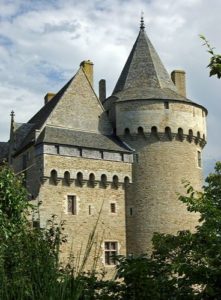Château de Suscino is on the south side of Presqu’île de Rhuys (see separate review). It is very photogenic with its pointed turrets and moat. There is a large car park surrounded by trees which has views across the salt marsh.
The original building was a 13thC manor which was later enlarged. A small chapel was built outside the moat as was the dove cote. The chapel burnt down in 1370 and was replaced by a chapel in the 14thC range. The Château was originally used as a hunting lodge but later used as a main residence of the Dukes of Brittany. Jasper and Henry Tudor lived here for a while. The Château fell into ruins in the 16thC when the family moved to Nantes. The stones were taken for use in local buildings.
When it was taken over by Morbihan Council in the 1970s it had no roof or internal floors. Restoration work began in 1986 and the 15thC range of buildings is still to be completed.
Entry is across a drawbridge, though a massive wooden doorway with carvings of two stags above into the 14thC building. A curtain wall separates this from the later 15thC buildings.
There are sign boards in each of the rooms. We were given a leaflet and excellent audio guide in English. There are guided tours in French. The ground floor rooms and grounds are easily accessible for people with mobility problems. However stairs to upper floors may present difficulties.
The tour begins in the eastern 14thC buildings. The general apartments were on the ground floor. The Duchess and children lived on the second floor and the Duke’s apartments were on the top floor. There was a household of 665 which included a personal bodyguard of 254. There were two large round towers in this part of the building which house spiral staircases. The layout on each floor was similar with two large rooms with smaller rooms off. There were two latrines on each floor which emptied into the moat.
The first room on the tour is the chambre à Parer which was the general reception area and had smaller sleeping quarters off which would have been used by important guests. It has a large relief sculpture on the wall of Olivier de Clisson from Château de Josselin. This dates back to the time when the Museum of Breton History was here. Beyond is the Salles des Banquets where meals were taken. The serving hatch in the wall can be seen. Meals began with strong cheese, soup, meat and vegetables, deserts, goats cheese and cakes. There are displays of tiles in both rooms.
The Chambre à Parer contains samples of 13thC tiles which were found in the moat. The tiles are 2-3” square. The patterns on the tiles were made by pressing a mould into the surface of the tile and pouring in a paler coloured clay before firing. There are tiles with fleur de lys, oak leaves and flower designs.
In the Salles des Banquets are examples of 14thC tiles discovered when the ruined church was cleared and an almost intact floor was found, dating from 1330-50. These tiles were coated with lead oxide before firing which gives a deep red glaze. Adding copper oxide gives a deep green glaze. If whit clay is used it was possible to get yellow and pale green shades. The tiles were air dried before firing. They would be laid in geometric patterns of different colours or else in large squares containing a decorative roundel with pictures of animals etc.
The Duchess’s quarters on the floor above contained the ceremonial bedchamber where she received honoured guests. There would have been a bed and a dresser displaying expensive silverware and china. The Duchess had her own personal steam room (Etuve). This is a sort of Turkish bath and the stoke hole is still visible. The upper wooden floor is missing but the drain hole can be seen. Her private bedchamber was beyond. Only the wardrobe mistress was allowed in here. The Duke had access by his own private spiral staircase from his rooms above. Any children would share these quarters with the Duchess.
Next to it is Sal du Duc, the Ceremonial Hall where the more important guests were received and entertained. It has a large stone fireplace. On the opposite wall were a series of stone steps which which were used to display expensive treasures. The private chapel is off this room. It had two small oratories. The Duchess sat in one and the Duke in the other. Each had a small fireplace and they could watch mass through a small window.
The Duke’s rooms are on the top floor. The rooms were lined with wooden panels which would have been lime washed to improve insulation. The main room has an exhibition on the restoration of the Château. Behind is the Duke’s private bedroom with latrine and his private staircase to the Duchess’s floor. There is a late 15thC loggia off this room which has good sea views but was probably built to give access to the ramparts and western buildings. There is a walkway over the main doorway with machicolations which gives access to the Guard’s quarters. The Duke’s personal body guard lived, slept and ate in these quarters while on duty. The rest of the time they were based on the ground floor. There are holes in the walls from where the support beams went during building. The support arches above the fireplace, windows and doors are very obvious. These were structurally important as it meant that lintels and stones could be removed and replaced without harming the strength of the building.
The eastern buildings are connected to the later 15thC western block by a curtain wall which has the remains of a 13thC defensive tower. The walkway along the top giving good views of the surrounding landscape and down into the courtyard.
The roof has been replaced on the 15thC buildings but the interior is still an empty shell with the remains of fireplaces on the walls and pigeons. It is awaiting restoration. The ground floor was reserved for storage and the living quarters were above. It is thought this building was used to house important guests.
The casement in the base of Tour Neuve has alcoves for 4 cannons. Each had a small recess to protect the person firing the cannon.
There is a small village on the seaward side with stone houses and a road to the beach.
We really enjoyed out visit.
A longer report of our week in Morbihan can be read here: www.slowtrav.com/tr/tripreport.asp?tripid=1981
Our pictures can be viewed here: http://wasleys.org.uk/france/brittany_11/ab_wk2/28/index.html









